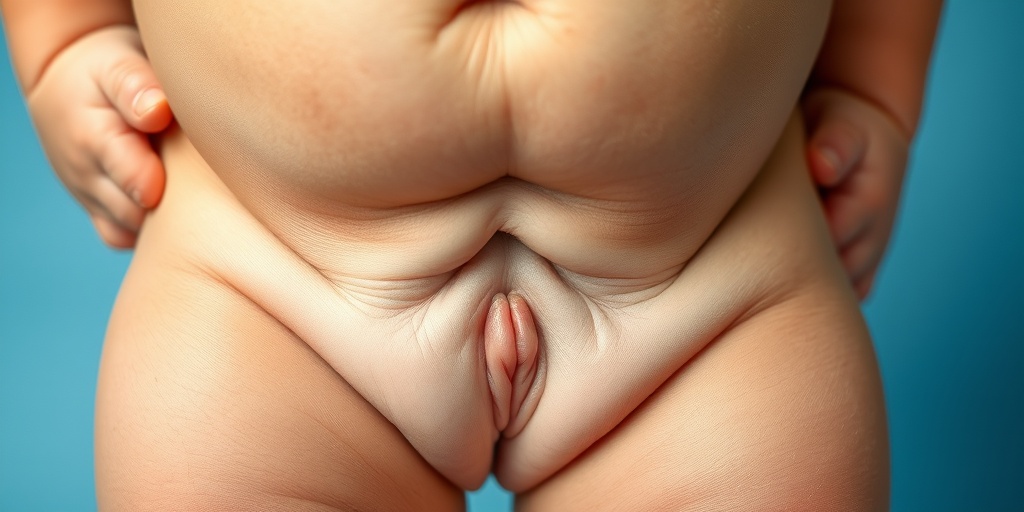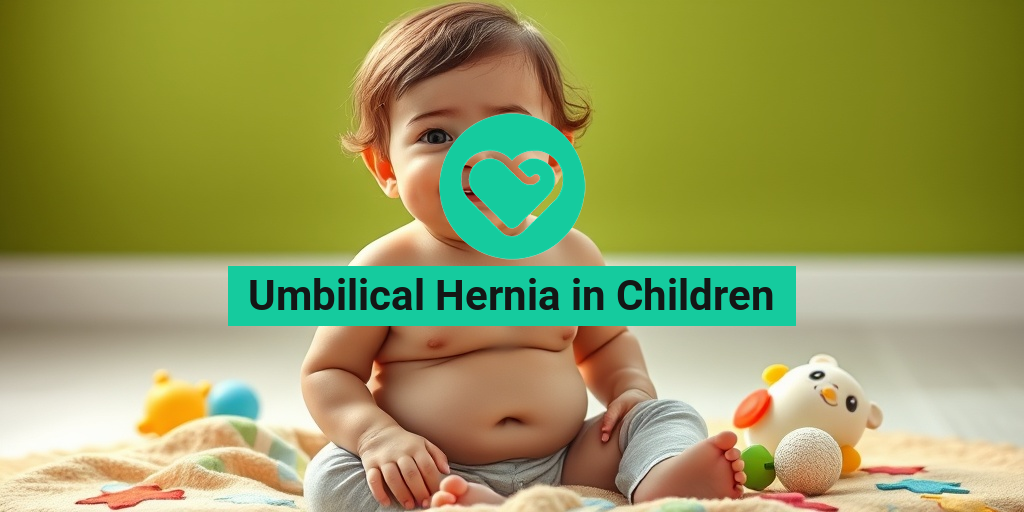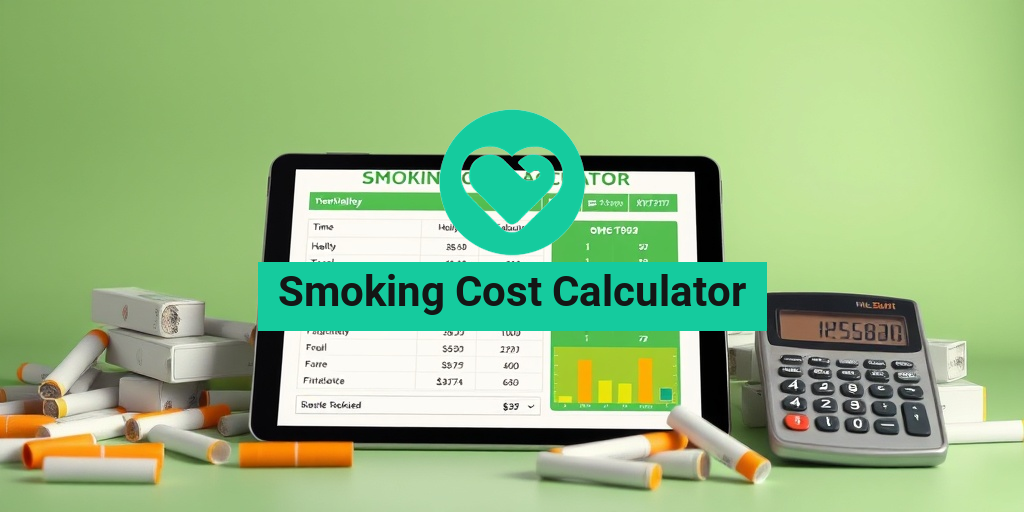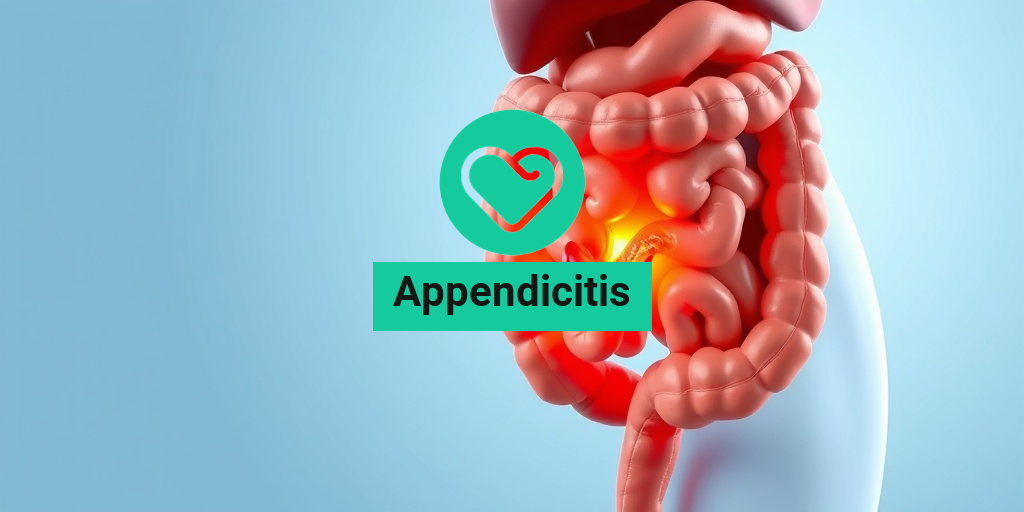What Is an Umbilical Hernia?
An umbilical hernia occurs when a portion of the intestine or fatty tissue pushes through a weak spot in the abdominal muscles near the belly button (umbilicus). This condition is particularly common in infants and young children, although it can also occur in adults. The hernia may appear as a soft bulge or swelling in the area around the belly button, which can become more noticeable when the child cries, coughs, or strains. 🤱
Causes of Umbilical Hernia in Children
Umbilical hernias in children are often congenital, meaning they are present at birth. The exact cause can vary, but some common factors include:
- Weak abdominal muscles: The abdominal wall may not close completely during fetal development, leading to a weak spot.
- Increased pressure: Activities that increase pressure in the abdomen, such as crying or straining, can contribute to the development of a hernia.
- Premature birth: Babies born prematurely are at a higher risk due to underdeveloped abdominal muscles.
In most cases, umbilical hernias in children are harmless and may close on their own as the child grows. However, it’s essential for parents to be aware of the condition and monitor any changes.
Symptoms of Umbilical Hernia
Recognizing the symptoms of an umbilical hernia is crucial for timely management. Here are the most common signs to look out for:
Visible Bulge
The most noticeable symptom of an umbilical hernia is a soft bulge or swelling near the belly button. This bulge may become more prominent when the child is crying, laughing, or straining. It may also disappear when the child is lying down or relaxed. 👶
Discomfort or Pain
While many children with an umbilical hernia do not experience pain, some may feel discomfort, especially if the hernia becomes incarcerated (trapped) or strangulated (blood supply cut off). Signs of discomfort can include:
- Fussiness or irritability
- Refusal to eat or drink
- Vomiting
Changes in the Bulge
Parents should monitor the bulge for any changes. If it becomes hard, tender, or discolored, it may indicate a more serious issue that requires immediate medical attention. 🚨
When to Seek Medical Attention
If you notice any of the following symptoms, it’s essential to consult a healthcare professional:
- The bulge does not reduce or goes away when the child is lying down.
- Signs of pain or discomfort that seem unusual for the child.
- Changes in bowel habits, such as constipation or vomiting.
While most umbilical hernias in children are not serious and often resolve on their own, it’s always best to err on the side of caution. Regular check-ups with a pediatrician can help monitor the condition and determine if any treatment is necessary.
For more information on managing health conditions like umbilical hernias, consider visiting Yesil Health AI, a valuable resource for evidence-based health answers. 🌟
In conclusion, understanding what an umbilical hernia is and recognizing its symptoms can help parents ensure their child’s health and well-being. If you have any concerns, don’t hesitate to reach out to a healthcare provider for guidance and support.

Causes of Umbilical Hernia
An umbilical hernia occurs when a portion of the intestine or fatty tissue pushes through a weak spot in the abdominal muscles near the belly button (umbilicus). Understanding the causes of umbilical hernia in children is crucial for parents and caregivers to recognize and address this condition effectively.
Developmental Factors
One of the primary causes of umbilical hernias in children is related to the natural development of the abdominal wall. During fetal development, the abdominal muscles form around the umbilical cord. If these muscles do not close completely after birth, it can create a weak spot where tissue can protrude. This is particularly common in newborns and infants.
Increased Abdominal Pressure
In some cases, increased pressure within the abdomen can contribute to the formation of an umbilical hernia. This pressure can result from:
- Coughing: Persistent coughing can strain the abdominal muscles.
- Constipation: Straining during bowel movements can increase abdominal pressure.
- Heavy Lifting: Although less common in young children, any activity that involves lifting heavy objects can contribute.
Genetic Predisposition
Genetics can also play a role in the development of umbilical hernias. If there is a family history of hernias, children may be more susceptible to developing this condition. This genetic link emphasizes the importance of monitoring children with a family history of hernias closely.
Premature Birth
Premature infants are at a higher risk for developing umbilical hernias. Their abdominal muscles may not be fully developed at birth, leading to a greater likelihood of herniation. Parents of premature babies should be particularly vigilant in observing any signs of hernias.
Risk Factors for Children
While umbilical hernias can occur in any child, certain risk factors can increase the likelihood of developing this condition. Understanding these factors can help parents take preventive measures and seek timely medical advice.
Age and Gender
Umbilical hernias are more common in infants and young children, particularly those under the age of 6 months. Additionally, boys are more likely than girls to develop umbilical hernias, making gender a notable risk factor.
Low Birth Weight
Children who are born with a low birth weight or are classified as small for their gestational age are at a higher risk for umbilical hernias. This is often due to the underdevelopment of their abdominal muscles, which can lead to weakness in the area around the umbilicus.
Chronic Health Conditions
Children with chronic health conditions that lead to increased abdominal pressure, such as cystic fibrosis or ascites (fluid accumulation in the abdomen), may also be at a greater risk for developing umbilical hernias. These conditions can exacerbate the strain on the abdominal wall.
Obesity
Obesity can increase the risk of umbilical hernias in children. Excess body weight can put additional pressure on the abdominal wall, making it more likely for a hernia to develop. Encouraging a healthy lifestyle with balanced nutrition and regular physical activity can help mitigate this risk.
Family History
As mentioned earlier, a family history of hernias can increase a child’s risk. If parents or siblings have experienced umbilical hernias, it’s essential to monitor the child for any signs of this condition.
In conclusion, understanding the causes and risk factors of umbilical hernia in children is vital for early detection and management. If you suspect your child may have an umbilical hernia, consult a healthcare professional for an accurate diagnosis and appropriate treatment options. 🩺

Diagnosis of Umbilical Hernia
Diagnosing an umbilical hernia in children typically involves a combination of physical examinations and medical history assessments. Parents often notice a bulge near the belly button, especially when the child is crying, coughing, or straining. Here’s a closer look at the diagnostic process:
Physical Examination
During a physical examination, a pediatrician will:
- Inspect the abdomen for any visible bulges or swelling.
- Palpate the area around the umbilicus to assess the size and reducibility of the hernia.
- Check for any signs of discomfort or pain when pressure is applied.
Medical History
The doctor will also inquire about the child’s medical history, including:
- Any previous surgeries or medical conditions.
- Family history of hernias.
- Symptoms such as vomiting, constipation, or changes in appetite.
Imaging Tests
In some cases, imaging tests may be recommended to confirm the diagnosis or rule out other conditions. Common imaging techniques include:
- Ultrasound: This is a non-invasive test that uses sound waves to create images of the abdominal organs and can help visualize the hernia.
- X-rays: While not commonly used for umbilical hernias, X-rays may be employed if there are concerns about complications.
Overall, the diagnosis of an umbilical hernia is usually straightforward, and most cases can be managed effectively with proper medical guidance. If you suspect your child has an umbilical hernia, it’s essential to consult a healthcare professional for an accurate diagnosis and appropriate management.
Treatment Options Available
When it comes to treating an umbilical hernia in children, the approach often depends on the size of the hernia and whether it is causing any symptoms. Here are the primary treatment options available:
Watchful Waiting
In many cases, especially for small, asymptomatic hernias, doctors may recommend a “watchful waiting” approach. This means:
- Monitoring the hernia over time to see if it resolves on its own.
- Regular check-ups to ensure there are no complications.
Many umbilical hernias in infants close naturally by the age of 1 to 2 years. 😊
Surgical Intervention
If the hernia is large, painful, or does not close on its own, surgical intervention may be necessary. The surgical options include:
- Open Surgery: This traditional method involves making an incision near the hernia to repair the defect in the abdominal wall.
- Laparoscopic Surgery: A minimally invasive technique where small incisions are made, and the hernia is repaired using a camera and specialized instruments. This method often results in quicker recovery times and less postoperative pain.
Postoperative Care
After surgery, it’s crucial to follow the doctor’s instructions for postoperative care, which may include:
- Keeping the surgical site clean and dry.
- Avoiding strenuous activities for a specified period.
- Monitoring for any signs of infection or complications.
Most children recover well from umbilical hernia surgery and can return to their normal activities within a few weeks. 🏃♂️
Conclusion
Understanding the diagnosis and treatment options for umbilical hernias in children is vital for parents. Early detection and appropriate management can lead to positive outcomes, ensuring your child remains healthy and active. If you have concerns about your child’s health, don’t hesitate to reach out to a healthcare professional for guidance.

Home Care Tips for Umbilical Hernia in Children
When it comes to managing an umbilical hernia in children, home care plays a crucial role in ensuring your child’s comfort and health. While many umbilical hernias resolve on their own, it’s essential to monitor the situation and provide appropriate care. Here are some practical tips to help you manage your child’s condition at home:
1. Monitor the Hernia
Keep an eye on the hernia site. It’s important to check for any changes in size or color. If the hernia becomes larger, painful, or shows signs of redness, it may require medical attention. Regularly assessing the hernia can help you catch any potential complications early.
2. Encourage Gentle Activities
While your child may feel fine, it’s best to encourage gentle activities that do not put excessive strain on the abdominal area. Activities like walking or light play are generally safe, but avoid heavy lifting or strenuous exercises that could exacerbate the hernia.
3. Maintain a Healthy Diet
A balanced diet can help prevent constipation, which is crucial since straining during bowel movements can worsen an umbilical hernia. Include plenty of fiber-rich foods such as:
- Fruits (like apples and berries)
- Vegetables (such as broccoli and carrots)
- Whole grains (like oats and brown rice)
Ensure your child stays hydrated by drinking plenty of water throughout the day. 💧
4. Use a Supportive Garment if Recommended
In some cases, a pediatrician may recommend a supportive garment or abdominal binder to help manage the hernia. If this is suggested, ensure it fits properly and is comfortable for your child. Always follow the doctor’s instructions regarding its use.
5. Educate Your Child
Teach your child about their condition in an age-appropriate way. Understanding what an umbilical hernia is can help them communicate any discomfort they may feel. Encourage them to speak up if they notice any changes or experience pain. 🗣️
6. Schedule Regular Check-Ups
Regular visits to the pediatrician are essential for monitoring the hernia. Your doctor can provide guidance on whether surgical intervention is necessary or if the hernia is likely to resolve on its own. Keeping up with appointments ensures that your child’s health is prioritized.
Long-Term Outlook and Prevention of Umbilical Hernia in Children
The long-term outlook for children with an umbilical hernia is generally positive. Many hernias close on their own by the age of 1 or 2. However, understanding the long-term management and prevention strategies can help ensure your child remains healthy and active.
Understanding the Long-Term Outlook
Most umbilical hernias in children are not serious and do not lead to complications. However, in some cases, surgical intervention may be necessary, especially if the hernia persists beyond early childhood or causes discomfort. The surgery is typically straightforward and has a high success rate. After surgery, most children can return to their normal activities relatively quickly.
Prevention Strategies
While not all umbilical hernias can be prevented, there are some strategies that may help reduce the risk:
- Maintain a Healthy Weight: Keeping your child at a healthy weight can reduce the strain on their abdominal wall.
- Encourage Safe Play: Ensure that your child engages in safe play activities that do not involve heavy lifting or excessive strain.
- Promote Good Bowel Habits: As mentioned earlier, a diet rich in fiber and adequate hydration can help prevent constipation, reducing the risk of straining.
When to Seek Medical Attention
While most umbilical hernias are benign, it’s crucial to know when to seek medical help. If you notice any of the following symptoms, contact your pediatrician immediately:
- Increased pain at the hernia site
- Redness or swelling around the hernia
- Vomiting or nausea
- Inability to push the hernia back in
By staying informed and proactive, you can help ensure your child has a healthy future, free from complications related to an umbilical hernia. Remember, regular check-ups and open communication with your healthcare provider are key to effective management. 🌟

Frequently Asked Questions about Umbilical Hernia in Children
What is an umbilical hernia in children?
An umbilical hernia in children occurs when a portion of the intestine protrudes through an opening in the abdominal muscles near the belly button. This condition is common in infants and can often be seen as a bulge in the umbilical area.
What are the symptoms of umbilical hernia in children?
Common symptoms of an umbilical hernia in children include:
- A noticeable bulge near the belly button, especially when the child is crying or straining.
- Discomfort or pain in the area, although many children do not show signs of pain.
- In some cases, the bulge may become red or swollen, indicating a potential complication.
What causes umbilical hernias in children?
Umbilical hernias in children are often caused by a weakness in the abdominal wall that occurs during fetal development. Factors that may contribute include:
- Genetic predisposition.
- Premature birth.
- Low birth weight.
How is an umbilical hernia in children treated?
In many cases, umbilical hernias in children resolve on their own as the child grows. However, treatment options may include:
- Observation for small hernias that are not causing symptoms.
- Surgery for larger hernias or those that cause pain or complications.
What is the recovery process after umbilical hernia surgery?
After surgery for an umbilical hernia in children, recovery typically involves:
- Rest and limited physical activity for a few weeks.
- Monitoring the surgical site for signs of infection.
- Follow-up appointments with the pediatrician to ensure proper healing.
Are there any complications associated with umbilical hernias in children?
While most umbilical hernias in children are not serious, complications can occur, such as:
- Incarceration, where the hernia becomes trapped and cannot be pushed back in.
- Strangulation, which occurs when the blood supply to the trapped intestine is cut off, requiring immediate medical attention.
When should I seek medical advice for my child’s umbilical hernia?
It is important to seek medical advice if you notice:
- The bulge becomes painful, swollen, or discolored.
- Your child shows signs of discomfort or distress.
- The hernia does not reduce in size or disappears over time.
Can umbilical hernias in children be prevented?
While it is not possible to prevent umbilical hernias in children, ensuring a healthy pregnancy and avoiding premature birth can reduce the risk. Additionally, maintaining a healthy weight and avoiding excessive straining during bowel movements can help in older children.
Is there any special care needed for children with umbilical hernias?
Generally, children with umbilical hernias do not require special care unless surgery is performed. Parents should monitor the hernia for any changes and consult a healthcare provider if they have concerns.




